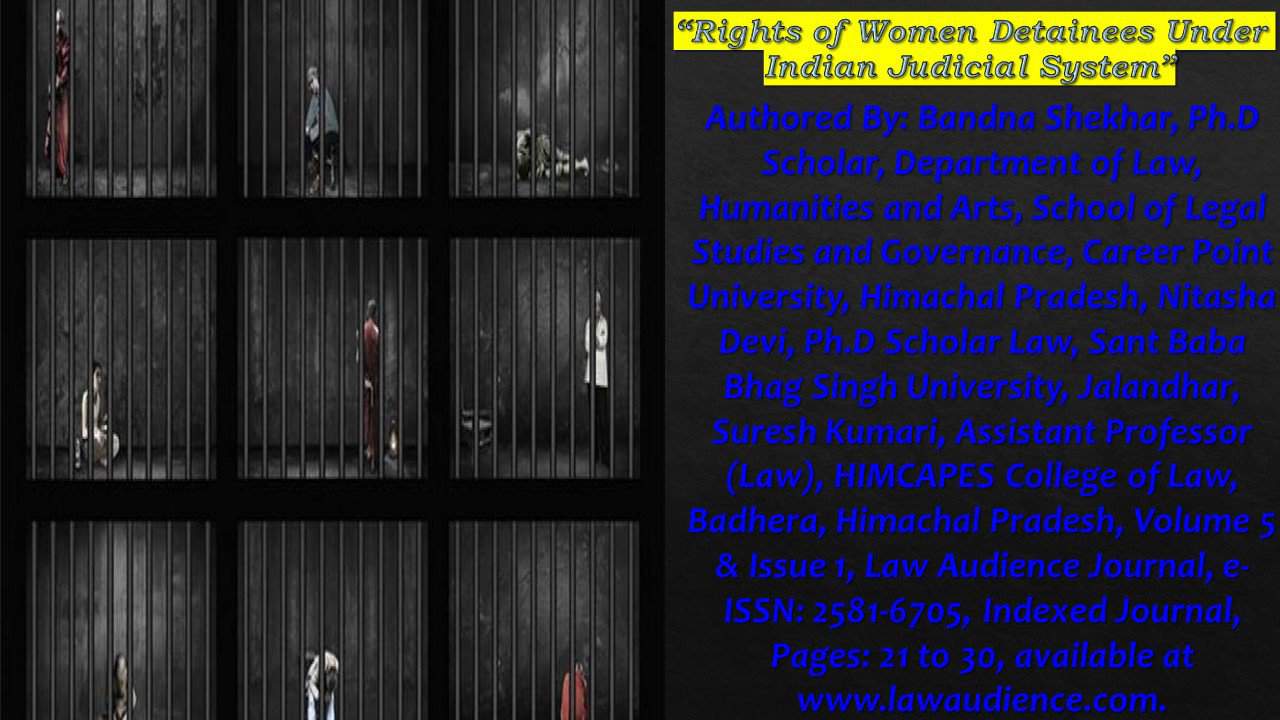Click here to download the full paper (PDF)
Authored By: 1. Bandna Shekhar, Ph.D Scholar, 2. Nitasha Devi, Ph.D Scholar, 3. Suresh Kumari, Assistant Professor (Law),
Click here for Copyright Policy.
Author(s) Details[1]*
ABSTRACT:
“Women always face several ups and downs in their social status. In present society also, the condition of women is not so good. various rights are provided to the women to improve their social status but women are totally ignorant to them due to lack of education and patriarchal society. Hitherto, there are various great women who are willingly enjoying their rights and socially empowered and they are making the glorious name of our country, but the ratio of these women is very few. Most of the women are dependent on their father, sons or husbands. The study of women criminality is neglected and it is not the primary area of research for the researchers. As few women are involved in the criminality and very few go to the prison, but the ratio is increasing day by day. There are several rights of women prisoners but seems to only on papers and only for specific section of the society. This present paper focuses on the rights of women prisoners in India and the problems of the women prisoners, violation of the human rights of the women prisoners, and to suggest the necessary changes that should be implemented despite various provisions regarding women prisoners’ rights”.
Keywords: Women Prisoner’s Rights, Sexual Harassment, Custodial Torture.
I. INTRODUCTION:
In the traditional society, women had very low status in the society. They do not enjoy rights of their life and face traditional patriarchal values system. But as the time passes, the Constitution of India provides various rights to bring upward change in the status of women to treat equally in the society. This brings a drastic change in the status of women. Traditionally, they were limited only to their houses but in present society, they are enjoying their rights yet the proportion of these women is very low. Still, women are facing torture, exploitation, harassment that increases the frustration level in women and they tend to commit crimes which are offensive and punishable by the law. The increasing trends of industrialization, urbanization, internet enhances crime rate in society and force women to commit crime against their nature which is generalized as very soft and delicate by the society. Although, very few women commit crime and a few go to prison, but the crime rate of women criminality is increasing in comparison to men. According to the National Crime Records Bureau (NCRB), the number of female prisoners in India at the end of the year 2021 was 22,918 while the capacity of the existing women jails in the country is enough to accommodate only 6,767 prisoners.
As per the NCRB data, in 2021, only 15 states/UTs have jails exclusively meant for women in the country. These 15 states/UTs have a total of 32 jails with a capacity of 6,767 prisoners. Only three women-only prisons were added to 29 women prisons in 14 states in the country in the year 2020. The data states that 21 states/UTs have surprisingly no separate women prisons at all. Women are sent to jail for the reformation and re-socialization to reintegrate in the society but prison system fails to meet its specific functions. The situation of women is found vulnerable and very pathetic in prison. There are many constitutional, legal, human rights provided to women prisoners and several committees recommendations talks about the reformation of them whether they are committed or under-trial. But all these are only on papers; the condition of women in prison is not good and reformative as they have to face a lot of problems within the system. They often being raped by the officers and they are not aware about their rights so that they can use them for their welfare.
II. RIGHTS OF WOMEN PRISONERS CAN BE CONSIDERED AS CONSTITUTIONAL RIGHTS:
Women prisoners have the right to live separately from the male and should be in inspection of female staff. Women prisoners should be allowed to keep their children with them until the children reach the age of 6 years. There should also have the facility of creche and nursery attached to prison. Prison should have the facility of proper medical care and child delivery for the pregnant women and separate female wing with lady gynaecologist should also be there for the regular medical check-up. Prison should have minimum and basic medical facilities under the system with all the necessaries of pre-natal and post-natal treatment for both mother prisoners and children. Women prisoners have right to speedy trial and free legal aid at the cost of state government. Women prisoners have right to have vocational training with skills in the useful trades to improve the life after prison. It is also there in the provision to have interview with their legal counsel, relatives and friends. Article 53(1) of The Standard Minimum Rules for the treatment of women prisoners: provides that they should be under the supervision of responsible women officer. Article 53(2) and 53(3) respectively states about no entry of men in the cell of women prisoners except accompanied by women officer for the supervision and attention. Mentally ill female prisoners should be kept separately to the other prisoners.
II.I LIST OF CONSTITUTIONAL RIGHTS OF WOMEN AND WOMEN PRISONERS:
- Article 6 of Indian constitution provides right to life for the people of India.
- Article 14 provides equal protection of laws to the women.
- Article 15 deals with the prohibition of discrimination on the grounds of sex, caste, race and colour.
- Article 21 guarantees a fundamental right to dignified secured life.
- Article 23 of Indian Constitution talks about protection against exploitation and restricts forced and unpaid labour.
- Article 15(3) guarantees to make any special kind of provision for the empowerment of women.
- Article 39(A) of the Constitution of India refers to empower women to secure free legal aid for their case.
III. INTERNATIONAL HUMAN RIGHT STANDARD APPLY TO THE IMPRISONMENT OF WOMEN:
UN standard minimum rules for the treatment of prisoners are still relevant and important they are only one part of the framework of International human rights standards that must be applied to imprisoned women. Understanding of issues such as gender, violence against women and child rights has progressed a great deal since the UN standard minimum rules were agreed in 1955. A person does not lose their human rights when they are imprisoned. As stated in the 1948. Universal declaration of human rights, the state may only limit the exercise of a person’s rights and freedom including the rights and freedom of a person who is a prisoner for the purpose of securing due recognition and respect for the rights and freedom of others and of meeting the just requirements of morality, public order and the general welfare in a democratic society. Pregnant prisoners should be provided with the same level of health care as is provided to women not in prison, including access to obstetricians, gynaecologists if required, and midwives or birthing practitioners appropriate to their culture. There should be 24-hour access to advice from midwives on whether the women need to go to hospital, but above facility have not been seen any prison, and pregnant women not to get appropriate food and health care in their prenatal period. The application of this principle in relation to imprisonment is set out in the basic principle for the treatment of prisoners. All prisoners shall retain the human rights and fundamental freedom set out in the universal declaration of human rights (General Assembly 1990) and any other UN human rights treaties to which their state is a party.
- Universal Declaration of Human Rights.
- International Covenants on Civil and Political Rights.
- International Covenants on Economics, Social and Cultural Rights.
- Convention on the Rights of the Child.
- Convention on the Elimination of all form of Discrimination Against Women.
- Convention on the Elimination of Racial Discrimination;
- Convention Against Torture and other Cruel, inhuman or Degrading.
- Article 3 of Universal Declaration of Human Rights provides right to life, liberty and security of every person and article 5 states that no-one shall be subjected to cruel, inhuman treatment.
- Article 10(1) of United Nations Covenant on Civil and Political Rights states that all persons deprived of liberty shall be treated equally and humanity.
Universal Declaration of Human Rights (UDHR), adopted by UN in 1948 recognizes the rights of all “members of the human family”. Art. 6 and 24 of the International Convention on the Rights of the Child also advocate for the best possible facilities to be provided to the mother and the child and ensuring optimum chances of their survival as well as nourishment.
IV. RECOMMENDATIONS OF NATIONAL EXPERT COMMITTEE:
The committee, headed by Justice Krishna Iyer in the year 1987, had given certain suggestions to the women prisoners in its report which are as following
- According to the policy of state, police should avoid to arrest the women until and unless any serious crime has not reported.
- In case of any reluctance, women should not be arrest between the times of sunset to sunrise without any female police officer.
- Bail should be granted as soon as possible in all cases of bail-able offences.
- Women should be kept in women ward only and minimum facilities should be arranged according to the necessities of women prisoners and their children.
- A woman should be examined only at her place of resistance. Police should not force her to investigate at police station unless her preference.
- All senior police officers should be worked to check the conditions of women prisoners under the custody.
- If, a woman is arrested by the police it should provide all necessary legal services. Police should also immediately inform the family and friends of the women arrestee.
- Data related to crime, arrest and disposal should be compiled sex-wise in all police stations.
- Officer should be punished by the magistrate on the violation of the above policies.
V. WOMEN PRISONER’S RIGHT UNDER THE PRISONER’S ACT, 1894:
Following sections of the Prisoners Act, 1894 describes rights of women prisoners in India:
V.I THE FEMALE PRISONERS HAVE THE RIGHT TO LIVE SEPARATELY FROM THE MALE PRISONERS:
Section 27(1) of the Prisoners Act 1894 provides that in a prison containing female as well as male prisoners, the females shall be imprisoned in separate buildings or separate parts of the same building, in such a manner as to prevent their seeing or conversing or holding any intercourse with the male prisoners.
V.II SECTION 31 OF THE PRISON ACT 1894:
Provides that a civil prisoner or an un convicted criminal prisoner shall be permitted to maintain himself, and to purchase, or receive from private sources at proper hours, food, clothing, bedding or other necessaries, but subject to examination and to such rules as may be approved by the Inspector General.
V.III ABOUT SUPPLY OF CLOTHING AND BEDDING TO CIVIL AND UNCONVICTED CRIMINAL PRISONERS:
Section 33(1) of the Prison Act, 1894 provides that every civil and un convicted criminal prisoner unable to provide himself with sufficient clothing and bedding shall be supplied by the Superintendent with such clothing and bedding as may be necessary.
V.IV Accommodation and sanitary conditions for prisoners:
V.V Provision for the shelter and safe custody of the excess number of prisoners who cannot be safely kept in any prison:
VI. RECOMMENDATIONS OF ALL INDIA COMMITTEE ON JAIL REFORMS:
The committee also known as Justice Mullah Committee and the recommendations of this committee are as follows:
- Women prisoners should be kept in separate place with gender-specific requirements and proper toilet facility.
- For under-trials women prisoners bail should be granted liberally.
- All general duties related to women prisoners should be performed by women officers and staff only. Pregnant women should be provided proper nutrition diet and health care for mother and children both.
- Women prisoners should allow following their cultural norms and values.
- Newly admitted women prisoners should be medically examined and pregnant women should be sent to local maternity hospitals for delivery.
- Prison should not be mentioned as birth place if a woman delivers a child in prison.
- Women prisoners should be permitted to maintain the contact with their families and friends.
- Children of the women prisoners should be kept in creche outside the prison.
- Children should preferably be kept with the family, relatives and friends of the women prisoners.
- The superintendent of the prison should take a monthly review and necessary actions regarding the condition of mother and children.
VII. OVERVIEW OF BASIC PROBLEMS OF WOMEN PRISONERS:
Some of the major problems of women prisoners in India:
- Overcrowding: Overcrowding is found as the root cause of every problem.
- Lack of nutritional food availability: The problem of unavailability of nutritional food negatively affects the health of female prisoners.
- Lack of medical services: Proper medical health care services with pre and post-natal treatment are not provided to women in prison.
- Lack of free legal aids: The Constitution of India has provided the right to free legal aid which is not implementing in the prison and women prisoners are unconscious about the right.
- Lack of gender-specific needs: India’s prison system is not able to meet the gendered specific requirements inside the prison and women find lack of necessities and privacy under the prison environment.
- Lack of rehabilitation facilities: Prison system of India does not provide technical skills programs, education, vocational training and awareness of the rights for the rehabilitation of women prisoners.
- Unsatisfactory living Conditions: Unsatisfactory living condition results in lack of basic necessities.
- Physical Harassment: Prison is regulated by the patriarchy and women are often violated and harassed by the male prisoners, staffs as well as by police in the custody.
- Lack of accommodation: The number of women prisoners are increasing but the structure of the prison remains the same as earlier which results in the problem of accommodation.
- Lack of education: Being as a reformative institution, prison system of India fails to launch the educational programmes for the reformation and re-socialization of women prisoners.
- Discriminated behaviour: Women are discriminated in prison system also because men prisoners are given more priority counterparts women.
- Lack of education: Being as a reformative institution, prison system of India fails to launch the educational programmes for the reformation and re-socialization of women prisoners.
- Discriminated behaviour: Women are discriminated in prison system also because men prisoners are given more priority counterparts women.
- Sexual abuse: Sexual assault of women prisoners shows exploitation and harassment in the prison instead of reformation. Asian Centre for Human Rights observed custodial rape as the worst form of sexual abuse in prison.
- Shortage of female prison: According to the National Crime Records Bureau (NCRB), the number of female prisoners in India at the end of the year 2021 was 22,918 while the capacity of the 32 existing women jails in the country is enough to accommodate only 6,767 prisoners. Among the 22,918 female prisoners, 1,650 women inmates had their children with them on the jail premises. Out of 22,918 female inmates, 1,418 inmates along with 1601 children were under-trail prisoners and 216 were convicted prisoners along with 246 children.
- Shortage of female staff: As per record of NCRB-2019, till 31st December 2019, the actual strength of jail-staffs is 60,787 in which only 7,794 were women jail-staffs/officers including 254 medical women staff.
VIII. IMPLEMENTATION OF WOMEN PRISONERS RIGHTS IN THE PRISON:
In modern society, everyone only talks about the equality, fraternity, women empowerment, girls’ education etc. but do not correctly implement in the society. It is very sad to have glimpse upon the pathetic and deplorable condition of women prisoners in the prison. It is such neglecting issue which need to have conscious attention for the overall development of the society. The constitution of India luckily provides some special rights and provisions for the women prisoners, but it is seemed that all these rights are only in the documents not implementing in the real time atmosphere and despite of having a number of direction from supreme court and high court, constitutional rights, human rights and recommendations of various committee, the condition of women is still found very neglecting, exploitative and pathetic that their basic human rights are violated under the four walls of the prison institution. Under the Prison Act 1894, there is only one article for the women prisoners to have separated prison counterpart male prisoners but in India there are 31women prisons specially designed according to their needs. Rest of the prisons are found neglecting this law and they kept male and female prisoners in the same jail/prison with male staff which leads to exploitation and sexual harassment of women.
IX. CONCLUSION:
Socio-economic condition of women prisoners is worse. Custodial violence in the prison is one of the major problems faced by the women prisoners. There are various rights which are provided to the female prisoners in India but the problem legging behind the proper implementation of these rights moreover most of the female prisoners are ignorant. Women prisoners who are mother are unable to take care of their children inside the jail premises due to poor facilities and arrangements made for them. Sanitation problem is one of the biggest problems faced by the women prisoners as women faces menstruation problem every month and still, they don’t get proper sanitation facility due to which they are get prone to various diseases. Lack of nutritious food is being provided to pregnant women which is causing a severe harm to the health of mother and child, thus pregnant women prisoners should be given extra facilities with nutritious food and healthy environment. Even the facilities of re-socialization provided to women prisoners to regenerate them is not being served properly. There is need for many separate women prisons in the country. Education should be provided to all sectors of women inside the prison, so that they should know their basic rights.
References & Footnotes:
Websites:
- Female Prisoners in India and Their Condition (1).pdf | NIDHI SINGH – Academia.edu
- https://papers.ssrn.com/sol3/papers.cfm?abstract_id=3621467.
- State of women prisons in India: Inadequate space or absolute lack of it (thestatesman.com).
- https://www.jagranjosh.co.in/amp/s/www.youthkiawaaj.com/2012/02/the-eplorablecondition-of-women-prisoner-in-india/amp.
- http://www.academia.edu/540727/RIGHTS_OF_WOMEN_PRISONERSIN_INDIA_AN_EVALUATION.
Acts & Sections:
- Section 4 of the Prisoners Act, 1894.
- Section 7 of the Prisoners Act, 1894.
Articles & Books:
- V.R. Krishnan Iyer, “Are not women human even in custody”. Human Rights Year Book (2000), P.94.
- Bastick, M.&Townhead, L (2008), Women in Prison: A Commentary on the UN Standard Minimum Rules for the treatment of prisoners.
- Prison Statistics India 2016 NCBR.
[1] Bandna Shekhar, Ph.D Scholar, Department of Law, Humanities and Arts, School of Legal Studies and Governance, Career Point University, Himachal Pradesh, email: bandnajaryal88@gmail.com, Nitasha Devi, Ph.D Scholar Law, Sant Baba Bhag Singh University, Jalandhar, email: Nitashathakur21@gmail.com, Suresh Kumari, Assistant Professor (Law), HIMCAPES College of Law, Badhera, Himachal Pradesh, email: Kumarisursh113@gmail.com.
Cite this article as:
Bandna Shekhar, Nitasha Devi & Suresh Kumari, “Rights of Women Detainees Under Indian Judicial System”, Vol.5 & Issue 1, Law Audience Journal (e-ISSN: 2581-6705), Pages 21 to 30 (25th February 2023), available at https://www.lawaudience.com/rights-of-women-detainees-under-indian-judicial-system/.



